The Makar Sankranti festival, unlike other Hindu festivals, is not dependent on the tithi (position of the moon) but on position of the sun. On this day, the sun enters the zodiac sign of Capricorn. Usually, Makar sankranti is celebrated on 14th January. But, to compensate for the difference that occurs due to the revolution around the sun, sometimes sankranti gets pushed ahead by one day. In 2024, Makar Sankranti will be celebrated on 15th January. Sankranti is considered as a Deity. According to a legend Deity Sankranti killed a demon named Sankarasur. Kinkrant is the day after Sankrant. On this day a Deity killed the demon Kinkarasur.
This is the biggest festival of the Sun God, the bestower of Life. This day is most important to also worship Shri Vishnu and Goddess Mahalakshmi.
Importance of Makar Sankranti
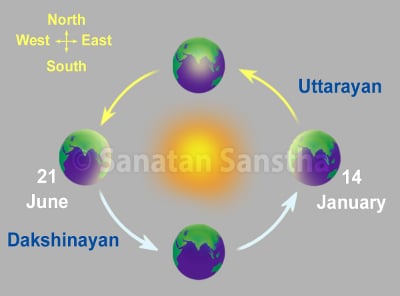
The northward movement (Uttarayan) of the sun begins on this day. The period from Karka sankrant (the passage of the sun into the zodiac sign of Cancer) till Makar Sankranti is called the Dakshinayan. A person who dies in the Dakshinayan period has a greater chance of going to Yamalok (southward region), than one who dies during Uttarayan (northward revolution).
What can you do on Makar Sankranti ?
Spiritually, this day is very conducive for spiritual practice and to imbibe Chaitanya in the environment. So certain activities are conducive to our physical, mental, and spiritual well-being. These activities have been listed below.
Donate to a worthy cause during this auspicious period
Spiritually, the period from Makar sankranti to Rathsaptami is an auspicious period and very conducive for spiritual practice and to imbibe Chaitanya from the environment. Any donation and meritorious deeds in this period prove more fruitful. Please consider donating generously to help Sanatan Sanstha’s mission of spreading spirituality. Currently we are collecting funds for the following needs.

INR 51,00,000
Annadaan
Food grains, Vegetables, Spices etc. to cook 2 meals for 1000 seekers per month

INR 9,10,000
Medical Equipment
Defibrillators, BP apparatus, ECG trolleys etc. to provide healthcare to the sick and elderly

INR 32,00,000
Kitchen Appliances
Roti machine, Kneading machine, large utensils, etc. to prepare meals

INR 10,00,000
Electrical Appliances
Water filter, Washing machine, Geyser, etc. for Sanatan’s Ashrams

INR 65,00,000
Computer Hardware
Servers, Network switches, Software licences, etc. for publication of books and website content

INR 33,00,000
Transportation
Electric 2-wheelers, Electric 4-wheeler, consumables, etc. to facilitate Adhyatma Prasar






Substances offered on Makar sankranti
An offering of new vessels, clothing, food, sesame seeds, pot of sesame seeds, jaggery, a cow, a horse, gold or land should be made depending on the capability. On this day, married women also make some offering. They take things from unmarried girls and give them sesame seeds and jaggery in return. Married women organise a ceremony of haldi-kumkum (applying vermillion and turmeric to the forehead) and gift articles to other married women.
Exchange of gifts by married women
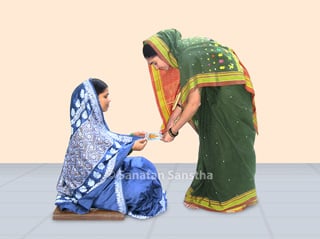
Giving a gift to another woman amounts to surrendering to the Divinity in the other, through body, mind and wealth. Since the period of Makar sankranti is favourable for spiritual practice, a gift given during this period results in bestowal of Divine grace and the individual gets the desired fruit.
Subtle Drawing depicting benefits of a sattvik gift
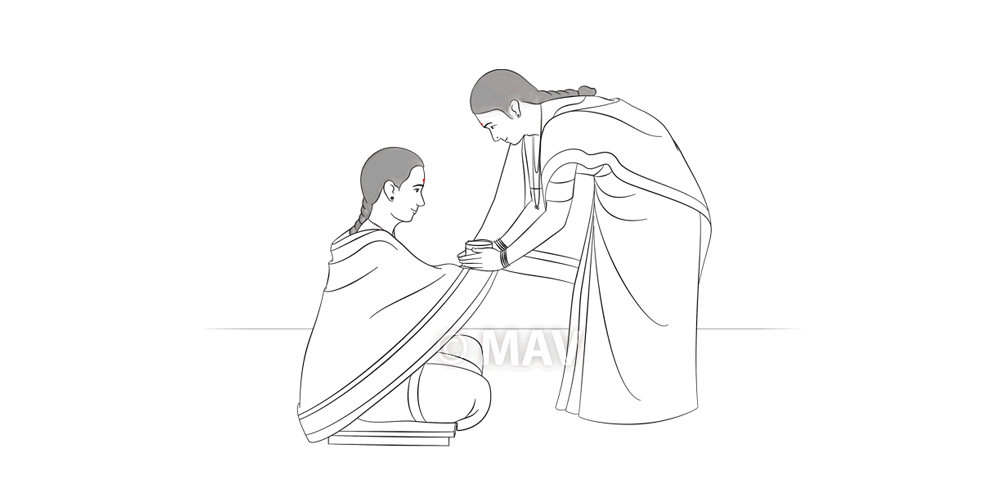
So this year, for Makar Sankranti, instead of gifting plastic stuff and steel boxes, gift substances that are complementary to spiritual practice and are indicators of a married life. For example incense sticks, ubtan (fragrant powder used during bath), religious texts, Holy texts, pictures of Deities, CDs on spiritual topics etc.
To buy sattvik gifts,
visit SanatanShop.com
Holy dip on the day of Makar sankranti
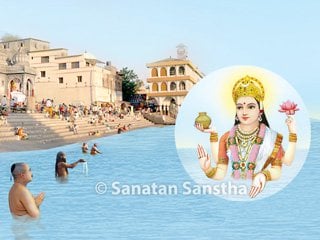
The time from sunrise to sunset on Makar sankranti is auspicious. A Holy dip during this period carries special significance. Those who take a Holy dip in the rivers Ganga, Yamuna, Godavari, Krushna and Kaveri at the Holy places situated on the banks of these rivers acquire the highest merit.
Importance of sesame seeds
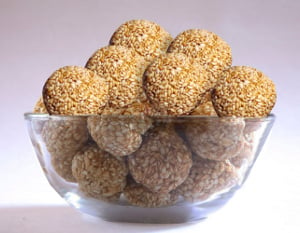
Sesame seeds have a greater ability to absorb and emit sattva frequencies. Consuming tilgul (a mixture of sesame seeds and jaggery) cleanses one at the spiritual level. Distributing tilgul to one another results in an exchange of the Sattva component along with increasing the positive attitude. Do keep the tilgul in front of the Deity before distributing, so that the sattva frequencies in it are preserved.
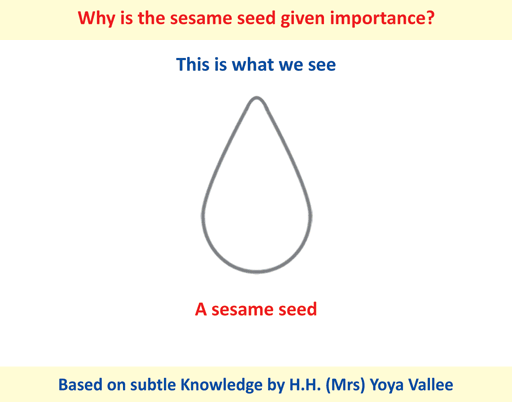
Hence there is a maximum use of sesame seeds during Makar Sankranti festival. For example, bathing with water containing sesame seeds, eating and distributing tilgul (a sweet made from sesame seeds), offering sesame seeds to Brahmans, lighting lamps of sesame oil in a temple of Deity Shiva, and performing pitrushraddh (rite for the departed ancestors) in which an offering of sesame seeds is made.
Haldi-kumkum ceremony
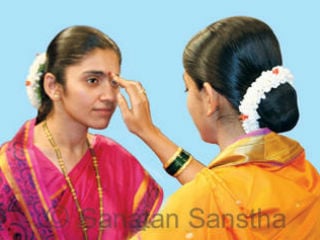
The Haldi-Kumkum ceremony (exchange of turmeric, and vermilion powder made of turmeric between married women) is carried out between Makar Sankranti and Rath Saptami. On Makar Sankranti, the Chandranadi (The moon channel) of the Universe gets activated, along with an increase in Raja-Sattva waves. This creates an environment that is conducive for spiritual growth. It is during such a period that the Haldi-Kumkum ceremony is conducted.
The application of Haldi (turmeric) and Kumkum (vermilion powder) to a married women activates the unmanifest principle of Goddess Durga Devi in her, which in turn actively helps the women applying the Haldi and Kumkum. This ceremony is, in a way, a means to invoke the unmanifest waves of the Goddess. Through this ceremony, one Jiva worships the Goddess residing within the other Jiva. By applying Haldi-Kumkum and offering gifts, the person imbibes a subconscious impression of physical worship while also increasing Bhav (Spiritual emotion).
Exchange of small mud pots
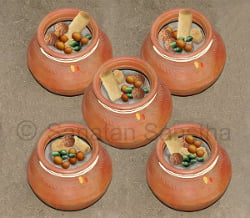
‘The festival of Makar sankranti requires small mud pots called sugad (in Marathi language). Vermilion and turmeric powder is applied to the pots and a thread is tied to them. They are filled with carrots, jujube fruits, sugarcane pieces, pods, cotton, chickpeas, sesame seeds with jaggery, vermilion, turmeric etc. Five pots are placed on a wooden seat, rangoli is drawn around the seat and worshipped. Of these, three are gifted to married women, one is offered to the Tulsi plant and one is retained.’
Do not wear black clothes on Makar Sankranti
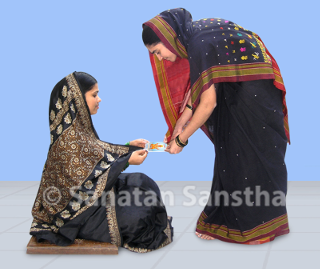
On Makar Sankranti little children and married women wear black clothes. Black colour is not only considered inauspicious in the Hindu Dharma but in Spirituality it is known to attract Tama frequencies from the environment. Thus wearing black can cause distress to the individual. As no Holy text substantiates the claim that ‘one should wear black clothing on Makar Sankranti or that wearing black is allowed on this day’, do not wear black clothing on this occasion.
If you come across any Holy book stating that black clothes should be worn on Makar Sankranti’ then kindly let us know on the email id : [email protected]
Makar Sankranti across India and South Asia
Sankranti is celebrated all over South Asia with some regional variations. It is known by different names and celebrated with different customs in different parts of the country.
Makar Sankranti across India
Makar Sankranti : Chhattisgarh, Goa, Odisha, Haryana, Bihar, Jharkhand, Andhra Pradesh, Karnataka, Kerala, Madhya Pradesh, Maharashtra, Manipur, Rajasthan, Sikkim, Uttar Pradesh, Uttarakhand, Bihar, West Bengal
Pongal, Uzhavar Thirunal : Tamil Nadu
Uttarayan : Gujarat
Maghi : Haryana, Himachal Pradesh and Punjab. A day before, people of Punjab celebrate Lohri (January 13th).
Bhogali Bihu : Assam
Shishur Saenkraat : Kashmir Valley
Khichdi : Uttar Pradesh and western Bihar
Makar Sankramana : Karnataka
Makar Sankranti across South Asia
Nepal : Maghe Sankranti
Tharu people, Maithali, Newar : Maghe Sankranti
Thailand : Songkran
Laos : Pi Ma Lao
Myanmar : Thingyan
Cambodia : Moha Sangkran
Sri Lanka : Pongal, Uzhavar Thirunal
– Collected by Ms. Supriya Jathar, Ramnathi Ashram, Goa
Safely celebrating Makar Sankranti during Covid-19 Pandemic
Consider the following points while celebrating Makar Sankranti.
1. All the rituals of the festival (e.g. Haldi-kumkum ceremony, giving ‘Tilgul’, ‘Bornhan’ etc.) should be performed by following all the rules laid down by the government considering the local conditions in your area to control the spread of COVID pandemic.
2. When organizing a haldi-kumkum ceremony, call the women in groups of 4, at 15-20 minute intervals, instead of inviting everybody at the same time.
3. Tilgul should be distributed in small bags avoiding direct exchange.
4. Use masks when meeting and greeting each other.
5. The purpose of celebrating any festival is to increase the ‘Sattva Guna’ within oneself. Therefore, even if due to adverse times, there are restrictions on celebrating the festival as per the traditions, we should try to increase the sattva guna (positivity) by devoting more time to stay in communion with God, chanting, and worshipping God. This would be celebrations in the real sense.
Is Makar Sankranti the same as winter solstice ?
There is no observance of winter solstice in the Hindu religion. Further, the Sun makes its northward journey on the day after winter solstice when day light increases. Therefore, Makar Sankranti signifies the celebration of the day following the day of winter solstice.
The date of winter solstice changes gradually due to the Axial precession of the Earth, coming earlier by approximately 1 day every 80 years. Hence, if the Makar Sankranti at some point of time did mark the day after the actual date of winter solstice, a date in mid-January would correspond to around 300 CE, the heyday of Bharatiya mathematics and astronomy.
Watch these videos too !
Reference : Sanatan’s Holy Text ‘Holy festivals, Religious festivals and Vowed religious observances’

To know more about how to celebrate festivals like Makar Sankranti in the most appropriate way so as to benefit maximum from them, and to attain individual progress,
Join us in our free online satsangs











 From this Gudhi Padwa, resolve to establish Ramrajya in your personal and social life !
From this Gudhi Padwa, resolve to establish Ramrajya in your personal and social life ! Message on Vijayadashami (Dussehra)
Message on Vijayadashami (Dussehra) Raksha Bandhan (2023 Dates)
Raksha Bandhan (2023 Dates) Desecration of Shri Ganesh through social media by publishing passport in His name!
Desecration of Shri Ganesh through social media by publishing passport in His name!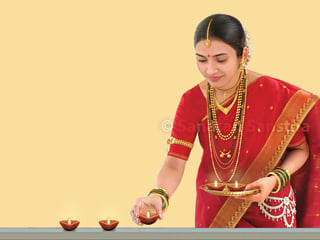 How to celebrate Deepawali in adverse times caused by coronavirus pandemic ?
How to celebrate Deepawali in adverse times caused by coronavirus pandemic ? Think whether you commit any inauspicious deeds on the auspicious occasion of Diwali !
Think whether you commit any inauspicious deeds on the auspicious occasion of Diwali !